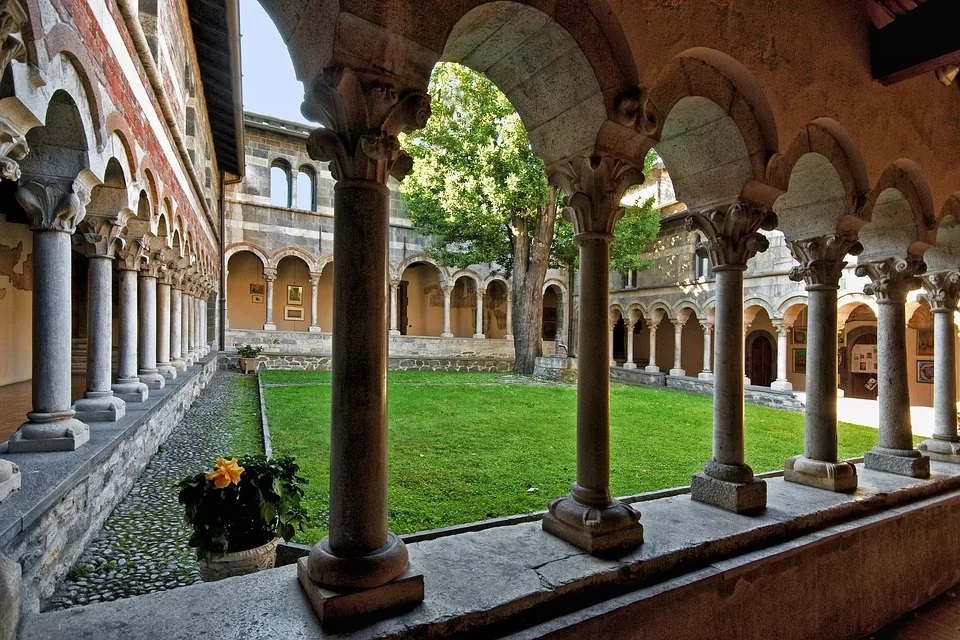The Abbey of Piona, Lake Como
The Abbey of Piona is set at the foot of Mount Legnone on the promontory of Olgiasca that stretches into the lake to form a beautiful bay, and not far from the shore of Lake Como.
Both the village and the Abbey of Piona belong to the Municipality of Colico, as well as the characteristic little lake at the back of the Monastery, on the road that from the village leads to Colico.
The Historian Gioseffo della Torre Rezzonico wrote about it:
“the territory of Colico is so rich of vineyards that normally produce twenty thousand jars (called brente) of wine per year. Nevertheless, sometimes the vine trees die because if the inclemency of the weather and because of the closeness of the very harsh mountains. The little lake of Pionais wonderfully rich of fishes, especially agoni, perches, carps which have their shelters into the caves the villagers call Garavina; sometimes they (fishes) reach the same size as those that are by the rocks of Grosgallo (near Lezzeno), as Paolo Giovio Lassazo asserts.”
The first founts that document the presence of a Monastic Community on this place go back to the 7th century A.C.
As a matter of facts, into the nowadays church there are two buildings: the church of Saint Nicolas which is the real focus of the Priorate of Piona; in a background position the remains of a former building that is to say a portion of the apse of the Oratorio built by Agrippino, which make us think of a small and cosy place and because its isolated position, it had to have the function of an ascetical and secluded place for praying and meditating.

Some centuries after, on the same place and above the same fundaments was built the church which we see also today.
At the beginning of the 20th century, inside the nowadays church, it was casually discovered an inscription which stated that in 1138 the temple was dedicated to the Blessed Virgin. So, at that date, the church already existed although with another dedication. It is not yet clear when and how happened the passage of the dedication of the church from the Blessed Virgin to Saint Nicolas; it is an enigma which is still subject of studies and speculations.
As you enter into the Abbatial compound, you can visit:
- the church;
- the cloister;
- the Capitular Room;
- the building where you can buy the typical products made by the Monks of Piona.
The church
Its entrance is set eastward; it is at one only nave 27 m. long, 8 m. wide and 9 m. high. The frescoes on the apse basin are of unknown medieval date and had been discovered in 1906. The frescoes on the vault of the Presbytery and of the Transept represent scenes of the Ascension of Jesus and Apostles. The nowadays building is the result of the extension of the church consecrated in 1138, which was probably made in the same century.
The geometry of the nave is rectangular, slightly irregular as the extensions are not perfectly in axe with the former outside walls.
The square bell-tower had been rebuilt toward the end of the 18th century, but on the opposite side of the church; the previous one which collapsed because of a landslide, was of octagonal plan on a square base.
The cloister
It is leaning against the south wall of the church and it was build in da later period, maybe to substitute a smaller previous one of which, anyhow, there are no documents. It is of square plan with a central garden and it constitutes the referring point for the whole Abbey. Like all the Monasteries, the cloister is a place for praying and meditating in silence and quietness.
The portico is closed by round arches leaning on slender granite columns which capital are characterized by being all different one from the other. This cloister has the harmonious aspect of the Romanesque architecture although the capitals suggest the influence of the French-gothic style or of the pure Cluny-gothic style.
The Capitular Room
it is still nowadays the meeting place for the Monks’ reading; where Father Superiors are elected by secret vote; where problems are discussed and where postulants are admitted to the novitiate. The pews are fine inlaid wood works which come from the sacristy of the church of Saint Zeno of Verona.
Shop of typical products made by the Monks
In there you can find herbal-teas, cosmetic creams, honey and the famous Herb Liqueurs masterly distilled following the Monks’ most ancient traditions. All products are biologic and made by the Monks.
More information:
Abbazia di Piona
23823 Colico, Lecco
phone +39.0341.940331.
Maggiori informazioni:
Abbazia di Piona 23823 Colico, Lecco
Tel. 0341 940331
How to get to the Abbey of Piona